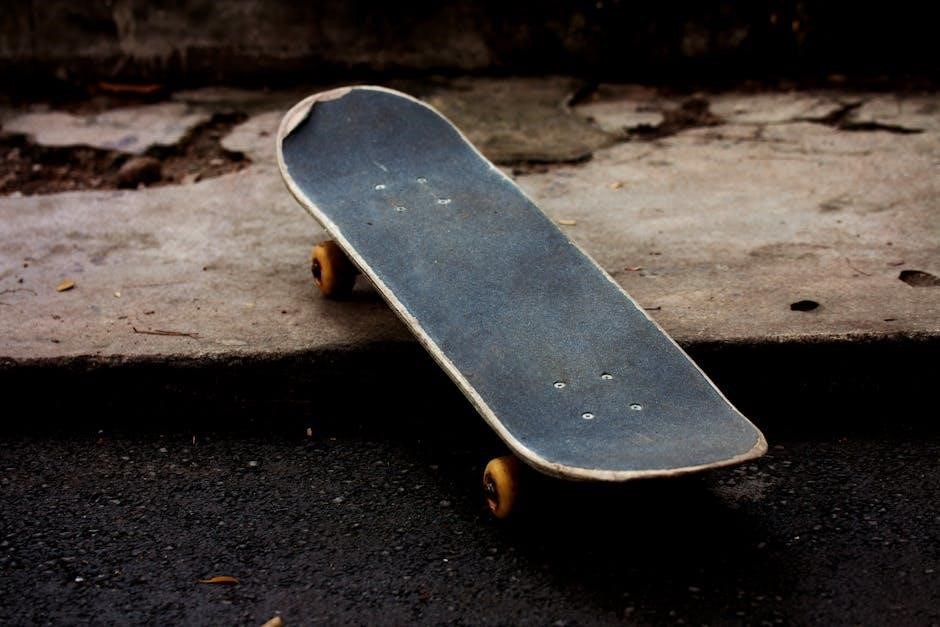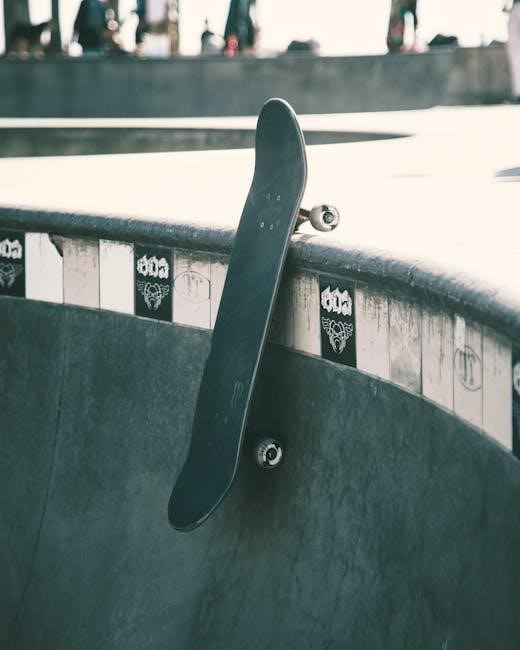Choosing the right skateboard size is crucial for stability‚ control‚ and performance. Deck width‚ length‚ and wheelbase vary to suit different skating styles‚ rider height‚ and personal preferences.
Importance of Choosing the Right Skateboard Size
Choosing the correct skateboard size is essential for optimal performance‚ comfort‚ and safety. A properly sized deck ensures better stability and control‚ allowing riders to execute tricks and maneuvers confidently. Skateboard size influences how well the board responds to movements‚ making it crucial for both beginners and experienced skaters. The wrong size can lead to discomfort‚ difficulty in balancing‚ or even frustration‚ especially for those learning new skills. Deck width‚ length‚ and wheelbase must align with the rider’s height‚ shoe size‚ skating style‚ and personal preference to maximize enjoyment and progress. The right size enhances the overall skating experience‚ making it vital to select carefully.

Understanding Skateboard Size Components
Skateboard size is determined by deck width‚ length‚ and wheelbase. Deck width affects stability‚ length impacts maneuverability‚ and wheelbase influences turning responsiveness. Understanding these components helps in making informed decisions when selecting the right skateboard size for your needs.
Deck Width: Key to Stability and Maneuverability
Deck width is a critical factor in determining stability and maneuverability. Typically ranging from 7.5 to 8.25 inches‚ narrower decks offer better control for technical tricks‚ while wider decks provide stability for cruising. Rider height‚ shoe size‚ and skating style influence the ideal width. For example‚ taller riders or those with larger shoes may prefer wider decks for comfort and balance. Conversely‚ street skaters often opt for narrower boards for agility. Personal preference plays a significant role‚ as some riders prioritize ease of movement‚ while others value a more stable platform. Ultimately‚ deck width should align with the rider’s style‚ terrain‚ and comfort level for optimal performance. This balance ensures a seamless skating experience.
Deck Length: A Matter of Personal Preference
Deck length is often a matter of personal preference‚ with most skateboards ranging from 28 to 32 inches. Longer decks provide a more stable platform‚ ideal for cruising or carving‚ while shorter decks are better for technical tricks and tight spaces; Rider height and shoe size can influence deck length‚ as taller individuals or those with larger feet may prefer longer boards for comfort. However‚ deck length is less critical than width or wheelbase‚ as it primarily affects the feel and maneuverability of the board. Ultimately‚ choosing a deck length comes down to how the rider intends to use the skateboard and what feels most comfortable for their style and terrain.
Wheelbase: The Most Important Measurement
The wheelbase‚ or the distance between the front and rear trucks‚ is often considered the most critical measurement for a skateboard’s performance. It directly impacts stability‚ turning radius‚ and overall ride quality. A longer wheelbase provides greater stability at higher speeds‚ making it ideal for cruising or carving‚ while a shorter wheelbase allows for tighter turns and sharper maneuvers‚ which is beneficial for street skating. The wheelbase is not a standardized measurement and can vary significantly between brands and models. Ultimately‚ the ideal wheelbase depends on the rider’s style‚ preferences‚ and the terrain they skate on‚ as there is no one-size-fits-all solution.

Factors Influencing Skateboard Size
Rider height‚ shoe size‚ skating style‚ and personal preference are key factors in choosing the right skateboard size for optimal comfort and performance.

Rider Height: A Starting Point for Size Selection
Rider height plays a significant role in determining the appropriate skateboard size. Taller individuals often prefer wider decks for better stability‚ while shorter riders may find narrower decks more manageable. Heights and deck widths generally correlate‚ with taller riders opting for boards between 8.0″ to 8.25″ in width‚ and shorter riders preferring sizes from 7.5″ to 7.75″. This starting point helps ensure the board feels balanced and proportional to the rider’s body‚ making it easier to control and maneuver. However‚ personal preference and skating style should also be considered alongside height for the best fit.

Shoe Size: Does It Matter for Skateboard Width?
Shoe size can be a helpful‚ but not definitive‚ factor in choosing skateboard width. Generally‚ smaller shoe sizes (US 6-8) may pair well with narrower decks (7.5″-7.75″)‚ while larger shoes (US 9+) might suit wider decks (8.0″-8.25″). However‚ this is a loose guideline rather than a strict rule. Personal comfort and skating style often outweigh shoe size. Some riders with larger shoes prefer narrower decks for technical tricks‚ while others with smaller shoes might opt for wider decks for stability. Ultimately‚ the best width is one that feels comfortable and allows for optimal performance based on individual preferences and skating terrain.
Skating Style: Street‚ Cruiser‚ or Transition
Your skating style significantly influences the ideal skateboard size. Street skaters often prefer narrower decks (7.5″-7.75″) for agility and technical tricks. Cruisers‚ on the other hand‚ benefit from wider decks (8.0″-8.5″) for stability and comfort over longer distances. Transition skaters‚ who skate ramps or pools‚ tend to favor balanced widths (7.75″-8;25″) for versatility and control. The style dictates how much foot space and maneuverability are needed‚ ensuring the deck size aligns with the skater’s performance goals and terrain preferences. Choosing the right size for your style enhances both performance and enjoyment‚ making it a critical factor in selecting a skateboard.
Personal Preference: What Feels Right for You
Personal preference plays a significant role in choosing a skateboard size. While factors like height and skating style provide a starting point‚ it’s essential to consider what feels most comfortable and natural to you. Some riders prefer a narrower deck for easier maneuverability‚ while others opt for a wider deck for better stability. Testing different sizes in person can help you determine which feels right. Ultimately‚ your skateboard should align with your unique needs and preferences‚ ensuring confidence and control. Trusting your instincts and prioritizing comfort will lead to a more enjoyable and effective skating experience.

Skateboard Sizes for Different Styles
Skateboard sizes vary to cater to distinct skating styles‚ ensuring optimal performance. Whether for street‚ cruiser‚ or transition skating‚ the right size enhances maneuverability‚ stability‚ and overall skating experience.
Street Skating: Narrower Decks for Technical Tricks
Street skating demands precision and agility‚ making narrower decks (7.5–8 inches) ideal for technical tricks. These decks provide better control and maneuverability‚ allowing skaters to perform flip tricks and ledge grinding with ease. Narrower widths also suit smaller shoe sizes and enable quicker pop‚ essential for street skating. Riders with a lower center of gravity often prefer narrower decks for improved balance. While personal preference plays a role‚ most street skaters opt for decks between 7.5 and 8 inches to master intricate maneuvers and maintain responsiveness. This size range strikes the perfect balance between stability and agility‚ catering to the dynamic nature of street skating.
Cruiser Skating: Wider Decks for Stability

Cruiser skating prioritizes comfort and stability‚ making wider decks (8.25–9 inches) the optimal choice. These decks provide a larger surface area‚ reducing wobble and enhancing balance at higher speeds. Wider decks are ideal for carving‚ commuting‚ or casual rides‚ offering better control on uneven terrain. They also accommodate larger shoe sizes and allow for a more relaxed skating style. While personal preference varies‚ wider decks are favored for their stability and forgiveness‚ making them perfect for longer cruises. The added width ensures a smoother ride‚ catering to skaters who value comfort and versatility over technical tricks‚ making cruiser skating enjoyable for all skill levels and terrains.
Transition Skating: Balanced Decks for Versatility
Transition skating requires a balanced deck size to ensure both stability and maneuverability‚ especially in terrains like bowls or pools. A medium deck width‚ typically between 8.0 and 8.5 inches‚ is ideal for this style. This size offers the necessary stability for transitioning between surfaces while maintaining the maneuverability needed for tricks and quick and precise turns. The balanced width supports various skating techniques within transition skating‚ accommodating different preferences and styles. Ultimately‚ the right deck size enhances performance and allows skaters to adapt seamlessly to the demands of transition skating.

Choosing the Right Trucks and Wheels
Trucks and wheels are essential for stability and maneuverability. They complement deck size‚ ensuring optimal performance for various skating styles and terrains.
Truck Size: Compatibility with Deck Width
Truck size must match your skateboard’s deck width for optimal performance. Proper alignment ensures stability and control‚ making it easier to maneuver. Narrower decks require smaller trucks‚ while wider decks need larger ones. Compatibility is key to achieving the right balance and responsiveness. Always check manufacturer guidelines for precise measurements to ensure your setup is cohesive and functional. This harmony between deck and trucks enhances your skating experience‚ whether cruising or performing tricks. A well-matched setup reduces the risk of instability and improves overall ride quality. Remember‚ the right truck size complements your deck‚ ensuring a smooth and enjoyable ride every time.
Wheel Size and Hardness: Terrain and Performance

Wheel size and hardness significantly impact your skateboarding experience‚ adapting to different terrains and riding styles. Larger wheels (56-60mm) are ideal for rough surfaces‚ offering stability and speed‚ while smaller wheels (48-54mm) suit technical tricks and tight spaces. Hardness‚ measured in durometer‚ ranges from soft (78A-87A) for grip on rough ground to hard (95A-101A) for speed and durability. Softer wheels excel in cruising‚ providing comfort‚ while harder wheels are better for street skating‚ offering precision. Choosing the right combination ensures optimal performance‚ whether navigating uneven streets or performing flips. Always select wheels that match your terrain and style for the best results and a smoother ride.
Choosing the right skateboard size enhances performance‚ comfort‚ and style. Consider deck width‚ wheelbase‚ and personal preferences to find your perfect fit for an optimal skating experience.
Final Tips for Selecting the Perfect Skateboard Size
When selecting a skateboard size‚ prioritize your skating style and personal comfort. Deck width should align with your shoe size and riding terrain‚ while wheelbase impacts stability. Experiment with different sizes if possible‚ as preferences vary. Consider consulting experts or reviews for additional insights. Ultimately‚ the right size enhances performance and enjoyment. Always balance practicality with personal preference to find the perfect fit for your unique skating needs and goals.
